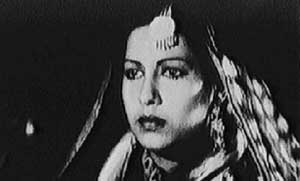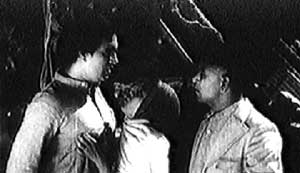GENESIS OF THE INDIAN POPULAR CINEMA The Forties: Religion, Romance and Revolt - part two
'Romance' in the Hindi popular film is a composite of diverse religious and cultural strains. The four films chosen - Kismet (1943), Rattan (1944), Barsaat (1949) and Andaaz (1949) - show traces of traditional elements intertwined with disruptive elements. At one level, the Hindi romantic film can be seen as swinging between the Laila-Majnu tradition (which includes Sohni-Mahiwal and Heer-Ranjha traditions) and the Radha-Krishna tradition. Briefly, the distinctive features and the common elements of these traditions are:
Radha-Krishna tradition: An evocation and elaboration of the here-and-now passion, an attempt to catch the exciting fleeting moment of the senses; not tragic but tender and ultimately cheerful; the Buddhist modification of this view in which the God of Love is identified with marana (death); an eroticism that is narcissistic in spirit, more hedonist than impassioned. Radha's absence of lust (kama) does not mean absence of desire: there is a pervasive presence of the adulterous in the narrative, an illicit trangression that brings a sharp charge to love. (Tales of Love. Sex and Danger, Kakar and Ross, OUP 1986). There are two features common to both traditions (at least at some levels). The love is not the Christian agape - spiritual love - but Eros - sexual love - raised to a spiritual plane; second, to quote the l3th century Persian poet, Rumi, "The house of love has doors and roof made of music, melody and poetry" (See any Hindi film.). Kismet at first glance may seem misplaced in this company. It is a comedy-thriller (the first and best of this genre). But see the romantic levels. It is three love stories. First, the love of the handicapped dancer for the criminal; second, of the dancer's sister for the rich man's son; third, of both sisters for their father. The dancer-criminal love is of the Laila-Majnu type, virtually blind devotion on her side; on his side, the 'sacrifice' is the risky burglary/risk of arrest he braves, so as to pay for her operation; the second affair, which is consummated, is more in the Radha-Krishna genre; the third love for the 'lost' father, of course, also belongs to the level of 'divine' love. Rattan too belongs to both traditions. The lovers' romance has the Radha-Krishna pastoral ambience. When the woman is married to an older man, shades of Duniya Na Maane creep in. But here comes the variation. Swarnalata is not a Shanta Apte but both a fullfledged Laila and a Radha. She attempts to remain faithful but yields to an illicit tryst (not consummated) and dies. So does her lover. Another variation. The husband, (played by Wasti) is no despot but a sufferer in the love game. His sexual desire for the wife is frankly revealed (in fact, one of the most revealing passages in Hindi cinema) and so is the guilt which makes him impotent. Barsaat (Raj Kapoor) and Andaaz are 'old-new' romances. Radha and Laila - Majnu and Krishna jostle uncomfortably with short-dresses, girls that go horse-riding and suited, bowtied men. Flute and sitar struggle to co-exist with violin and piano. The rude conjunction of Oriental and Occidental popular cultures set by these films, itself became an archetype for romance till the present day. Superficial gimmicks - the horse race to death with the lover dashing to the rescue, the romantic misunderstanding - survive intact. But so do deeper attitudes. The Radha-Krishna pastoralism is obvious and powerful. It is the lyrics and the music which lift Barsaat above the rut. It is not that they are good in themselves - many Hindi film songs are - but they are woven into the fabric of the film as much as in Pyaasa. The title song's reference to rain, Barsaat Mein Hum Se Mile Tum Sajan Tum Se Mile Hum. Barsaat Mein. Thak Dhina Dhin (It was raining when we met) with its hint at both the sensuousness and ephemerality of love, connects at one end with the l6th century princess poet Mirabai's song, "Months of Shravan and Badhon... send down teardrops like the rain;" and, at the other, with the lovely line in Betaab of the eighties, Aag Barasti Hai Savan Mein Paani Ka Hai Naam (We call it rain but it is the fire of passion which descends). The theme of rain or water as life-giver and destroyer reverberates down the decades. The Laila theme comes up in the passions both of Nargis and Nimmi - their passion is selfeffacing and 'divine'. Nimmi kisses Premnath's feet, Nargis swoons at Raj Kapoor's feet (a homage she repeats in Andaaz). Finally, here (as in Andaaz) the link between Eros and Thanatos, the God of Death, is established in Nimmi's suicide, Nargis' near-death in the river (Sohni-Mahiwal), and Dilip's killing by Nargis in Andaaz.
The free and open-ended myths of Laila and Radha have run aground in Barsaat and Andaaz. At the first whiff of dangerous dissent, of the possibility of ambiguity in adult love, traditions have folded up, their freshness gone. The stalemate continues to this day. The 'revolt' of the forties owes much to both 'religion' and 'romance'. All the films considered here were directed by Mehboob: Aurat (1940), Roti (1942), and Elan (1947). Aurat (1940), later remade (in what I now consider to be the weaker version) as Mother India, is one of the great archetypal films of our cinema. The mythological archetypes - peasant mother Sardar Akhtar can be seen as Durga, the rebellious son Birju as Krishna and the good son as Ram. This archetypal syndrome is repeated with remarkable fidelity not only in the remake but in Deewar of the seventies and the eighties TV opera Buniyaad. Sardar Akhtar, Nargis, Nirupa Roy and Aneeta Kanwar [le attrici che impersonano le "madri" dei tre film citati] are Mother Goddesses - not only givers of prosperity but also dispensers of food to mankind (Annapurna, the Goddess of Food). If she turns away her face, there will be famine and starvation - or death as in the case of Yakub, Sunil Dutt and Amitabh [gli attori che impersonano i "figli" nei film citati]. But, in death, the rejected (secretly favoured) child 'returns' and dies in the arms of the mother - a cataclysmic event, the implications of which are both too obvious and too vast to be elaborated here. There is one aspect of this divine 'triangle' that is often neglected - the implications of the rebellious son. Birju is 'black'. This can be seen as a reference to Krishna, 'the Black One'. Birju, like his great archetype, is naughty, playful, changeable, seemingly perverse. But if he is a symbol of Krishna, it is a symbol of an epic hero not "of God, far less God" (Chaudhuri). However, later in the film, Birju departs decisively from divinity - both literally as well as metaphorically. Whereas the Mother in all the three films preserves both the archetype (as commonly accepted) and the social order, Birju subverts both. He himself becomes a different archetype - a role model for hundreds of Hindi film heroes to follow. He is, in the modern sense, an 'outsider', outside the pale of caste or dharma. Attempts have been made to trap Birju into mythology as a renouncer. Birju is no renouncer. He likes action - and women. He is certainly a radical in a very special - almost Foucaltian - sense. For he has grasped that 'knowledge' is a technique of power and if you must seize power without becoming an 'interpreter' (which a peasant cannot) you must destroy knowledge. This is the meaning of two great scenes in Aurat where Yakub goes beyond Sunil Dutt (Mother India) or Amitabh (Deewar): First, his fury when he cannot 'read' the moneylender's books to challenge his taking away of a portion of the crop; second, when in a burst of savage sarcasm (he is the predator-bandit now) he destroys the account books saying "It is this knowledge that has destroyed us." The theme of knowledge/civilisatioh as power is pursued relentlessly in Roti. When Roti was telecast this year, Kundan Shah told me: "The first part was terroristic, but the film trailed off in the second half". This is right. But the reasons for this 'change' are interesting. The hand of German Expressionism lies heavy on Roti. Also, the already described burden of increasing material deprivation in India - Roti is a naked film. It's also a cliché-ridden, awkward film. But its nudity lifts it up. A poor man (Chandramohan) becomes a rich industralist by duplicity, ruthlessness, and treachery. His greed leads him to a primitive communist paradise where he meets a noble savage (Sheikh Mukhtar) and his mate (Sitara). He and his partner, Darling (Akhtari Begum) look foolish in this Eden. They make their way back with Mukhtar's and Sitara's help. When the noble savages come to the city to fetch their taken-away cattle, they become slaves of the industrial culture. The fairy-tale - part cautionary though - ending can be ignored. What remains is the powerful "ravening greed" of the newly-risen Indian bourgeoisie, conjured through stylised dialogue, lighting and decor. Mehboob catches the basic shift in the Indian power complex as no one else has done. His picture of primitive communism may be idealised. But take the disintegration of Sheikh Mukhtar and Sitara in the city to stand for the brutalization of the uprooted rurals and you will realise both the 'poetry' and the 'pity' in Roti. Elan again, at one level, can be seen as a conventional 'Nawab Muslim social'. Also perhaps as a 'communal' film (it was briefly banned) because Munnawar Sultana sings with Muslim children at the end, waving green, crescented flags, Insaan Ki Thahzeeb Pe Ehsan Hamaara / Har Mulk mein Phaila Hai Quran Hamara (World culture owes a debt to us / Our Quran has spread to every land). But Elan is the most revolutionary Muslim social ever made. Its heroes are what Prof. Hamza Alavi (Mainstream, Feb. 21, 1987) called "secular Muslim nationalists". For all its religious idiom, Elan is one of the few of our films to openly welcome westernisation. An European woman marries into a Muslim family, does not bother to cover her legs, becomes an implicit criticism of traditionalism. The controversial song itself is a powerful call for removal of ignorance and backwardness of Muslims. Of course, the film is also an expression of Muslim self-identity - a problem which has persisted to this day though without expression in cinema. The forties cinema in form and style was a prelude to the golden fifties. But in the nakedness of its themes, in the purity and originality of its variations, it remained unequalled till the eighties - the decade of Mirch Masala.
Note Ram: re di Ayodhya ed eroe del poema epico Ramayan, considerato la settima epifania del dio Vishnu. Dharm: legge divina che sostiene l'universo, in senso lato, legge morale, religione..
Iqbal Masud Film citati nell'articolo (regista, anno, lingua): A cura di |



